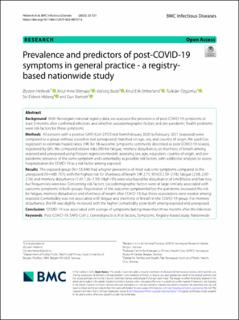| dc.description.abstract | Background With Norwegian national registry data, we assessed the prevalence of post-COVID-19 symptoms at least 3 months after confirmed infection, and whether sociodemographic factors and pre-pandemic health problems were risk factors for these symptoms. Methods All persons with a positive SARS-CoV-2 PCR test from February 2020 to February 2021 (exposed) were compared to a group without a positive test (unexposed) matched on age, sex, and country of origin. We used Cox regression to estimate hazard ratios (HR) for 18 outcome symptoms commonly described as post-COVID-19 related, registered by GPs. We compared relative risks (RR) for fatigue, memory disturbance, or shortness of breath among exposed and unexposed using Poisson regression models, assessing sex, age, education, country of origin, and pre-pandemic presence of the same symptom and comorbidity as possible risk factors, with additional analyses to assess hospitalisation for COVID-19 as a risk factor among exposed. Results The exposed group (N = 53 846) had a higher prevalence of most outcome symptoms compared to the unexposed (N = 485 757), with the highest risk for shortness of breath (HR 2.75; 95%CI 2.59–2.93), fatigue (2.08; 2.00-2.16) and memory disturbance (1.41;1.26–1.59). High HRs were also found for disturbance of smell/taste and hair loss, but frequencies were low. Concerning risk factors, sociodemographic factors were at large similarly associated with outcome symptoms in both groups. Registration of the outcome symptom before the pandemic increased the risk for fatigue, memory disturbance and shortness of breath after COVID-19, but these associations were weaker among exposed. Comorbidity was not associated with fatigue and shortness of breath in the COVID-19 group. For memory disturbance, the RR was slightly increased with the higher comorbidity score both among exposed and unexposed. Conclusion COVID-19 was associated with a range of symptoms lasting more than three months after the infection. | en_US |

